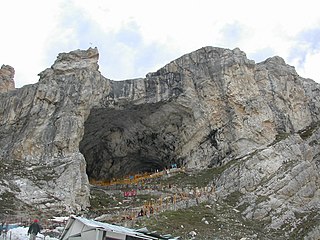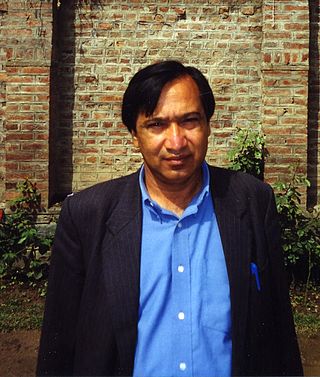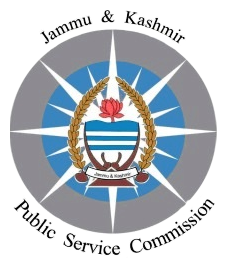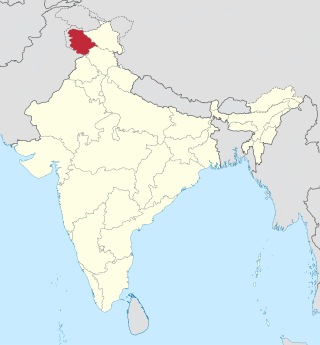
Srinagar is the largest city and the summer capital of the Indian-administered union territory of Jammu and Kashmir in the disputed Kashmir region. It lies in the Kashmir Valley on the banks of the Jhelum River, and Dal and Anchar lakes, between the Hari Parbat and Shankaracharya hills. The city is known for its natural environment, various gardens, waterfronts and houseboats. It is also known for traditional Kashmiri handicrafts like the Kashmir shawl, papier-mâché, wood carving, carpet weaving, and jewel making, as well as for dried fruits. It is the 31st-most populous city in India, the northernmost city in India to have over one million people, and the second-largest metropolitan area in the Himalayas.

Amarnath Temple is a Hindu shrine located in Anantnag district of Jammu and Kashmir, India. A cave situated at an altitude of 3,888 m (12,756 ft), about 168 km from Anantnag city, the district headquarters, 141 km (88 mi) from Srinagar, the summer capital of Jammu and Kashmir, reached through either Sonamarg or Pahalgam. The shrine represents an important part of Hinduism. The cave, located in Sind Valley, is surrounded by glaciers, snowy mountains and is covered with snow most of the year, except for a short period in the summer, when it is open to pilgrims. In 1989, pilgrims numbered between 12,000 and 30,000. In 2011, the numbers reached a peak, crossing 6.3 lakh (630,000) pilgrims. In 2018 pilgrims numbered 2.85 lakh (285,000). The annual pilgrimage has varied between 20 and 60 days.

The High Court of Jammu & Kashmir and Ladakh is the common high court for union territories of Jammu and Kashmir and Ladakh. It was established as the High Court of Jammu and Kashmir on 26 March 1928 by the Maharaja of Jammu and Kashmir. The seat of the court shifts between the summer capital Srinagar and winter capital Jammu. The court has a sanctioned judge strength of 17, 13 of whom are permanent judges, and 4 are additional judges. Since 13 February, 2023, the chief justice of the court is Hon'ble Shri Justice N. Kotiswar Singh.

Baramulla, also known as Varmul in Kashmiri, is a city and a municipality in the Baramulla district in the Indian union territory of Jammu and Kashmir. It is also the administrative headquarters of the Baramulla district, located on the banks of the River Jhelum downstream from Srinagar, the summer capital of Jammu and Kashmir. The town was earlier known as gateway of Kashmir, serving as the major distribution centre for goods arriving in Kashmir valley through the Jhelum valley cart road.
Pulwama is a city and notified area council in the Pulwama district of the Indian union territory of Jammu and Kashmir. It is located approximately 25 kilometres (16 mi) south of the summer capital of the state, Srinagar.

Awantipora or Avantipur or Aavantipur, known as Woontpor in Kashmiri, is a town, just opposite of Pulwama city, on the banks of the river Jhelum in the Pulwama district of Jammu and Kashmir, India. It is on the Jammu-Srinagar National Highway, south of Srinagar and north of Anantnag. Awantipora was named after the Kashmiri king Avantivarman and has the ruins of two 9th century Hindu temples built by him.

Jammu and Kashmir is home to several valleys such as the Kashmir Valley, Chenab Valley, Sindh Valley and Lidder Valley. Some major tourist attractions in Jammu and Kashmir are Srinagar, with its renowned Dal Lake and Mughal Gardens, Gulmarg, Pahalgam, Bhaderwah, Patnitop and Jammu. Every year, thousands of Hindu pilgrims visit holy shrines of Vaishno Devi and Amarnath which has had a significant impact on the state's economy.
Sher-e-Kashmir Stadium is a cricket stadium located in Srinagar, India. It is home to the JKCA and Jammu and Kashmir cricket team which represents the Indian union territory of Jammu and Kashmir in the Ranji Trophy and other domestic tournaments in the country. National Cricket Academy is currently constructing an indoor complex at the stadium.
On 26 May 2008, the government of India and the state Government of Jammu and Kashmir reached an agreement to transfer 99 acres (0.40 km2) of forest land to the Shri Amarnathji Shrine Board (SASB) in the main Kashmir valley to set up temporary shelters and facilities for Hindu pilgrims. This caused a controversy, with demonstrations from the Kashmir valley against the land transfer and protests from the Jammu region supporting it. The largest demonstration saw more than 500,000 protesters at a single rally, among the largest in Kashmir's history.

Mohammed Yousuf Tarigami is an Indian politician from Jammu and Kashmir. He is the Convenor and Spokesperson of People’s Alliance for Gupkar Declaration.

The State flag of Jammu and Kashmir was a symbol used in the former Indian state of Jammu and Kashmir between 1952 and 2019, under the special status accorded to the region by Article 370 of the Constitution of India. It was a red-and-white flag with a representation of a plough and three constituent regions of the state. After the abolition of Article 370 in August 2019, this flag lost its official status.

Elections in the Union Territory of Jammu and Kashmir are conducted in accordance with the Constitution of India to elect the representatives of various bodies at national, state and district levels including the 114 seat unicameral Jammu and Kashmir Legislative Assembly and the Parliament of India. The first elections in the Union Territory of Jammu and Kashmir took place between 28 November and 19 December 2020 in the form of by-elections to District Development Councils and municipal and panchayat level bodies. A fresh delimitation process for assembly constituencies began in February-March 2020.

Jammu is the winter capital of the Indian-administered union territory of Jammu and Kashmir in the disputed Himalayan region of Kashmir.It is the headquarters and the largest city in Jammu district of the union territory. Lying on the banks of the river Tawi, the city of Jammu, with an area of 240 km2 (93 sq mi), is surrounded by the Himalayas in the north and the northern plains in the south. Jammu is the second-most populous city of the union territory. Jammu is known as "City of Temples" for its ancient temples and Hindu shrines.

The following outline is provided as an overview of and topical guide to Jammu and Kashmir:

Popular sports in Jammu and Kashmir include cricket, football and winter sports along with sports like golf, water sports, Ice stock sport and adventure sports. The National Winter Games have been held in Gulmarg in 1996, 2004 and 2009. The first Khelo India Winter Games were held in February and March 2020 in Leh and Gulmarg. Jammu and Kashmir won the most gold medals while the Indian Army team came second with 8 gold medals. The second edition of the winter games were also held successfully in Gulmarg in 2020 with Jammu and Kashmir coming first and Karnataka second.

Jammu and Kashmir Public Service Commission widely known as JKPSC, is a constitutional body formed by the Government of India under articles 128 and 133 which conducts the civil services examination for appointment to various civil services in the Indian administered union territory of Jammu and Kashmir. The JKPSC, autonomous body select the officers for various key positions in state civil services according to the merits of the candidates and the rules of reservation.

Jammu and Kashmir is a region administered by India as a union territory and consists of the southern portion of the larger Kashmir region, which has been the subject of a dispute between India and Pakistan since 1947, and between India and China since 1962. The Line of Control separates Jammu and Kashmir from the Pakistani-administered territories of Azad Kashmir and Gilgit-Baltistan in the west and north. It lies to the north of the Indian states of Himachal Pradesh and Punjab and to the west of Ladakh which is administered by India as a union territory.
Junaid Azim Mattu is an Indian politician from Jammu and Kashmir. He is a member of the Jammu and Kashmir Apni Party, and is currently the Mayor of Srinagar. He is head of the Jammu and Kashmir Apni Youth Federation as President.

The 2019–2021 Jammu and Kashmir lockdown was a preventive security lockdown and communications blackout that had been imposed throughout the Indian-administered union territory of Jammu and Kashmir following the revocation of Article 370 which lasted until February 2021, with the goal of preemptively curbing unrest, violence and protests. Most separatist leaders had and have been detained in the crackdown. The Indian government had stated that the tough lockdown measures and substantially increased deployment of security forces had been aimed at curbing terrorism. The government did not want a repeat of the death and injuries seen during the 2016–2017 Kashmir unrest.
The first case of the COVID-19 pandemic in India was reported on 30 January 2020, originating from China. Slowly, the pandemic spread to various states and union territories including the Indian-administered union territory of Jammu and Kashmir. Two suspected cases with high virus load were detected and isolated on 4 March in Government Medical College, Jammu. One of them became the first confirmed positive case on 9 March 2020. Both individuals had a travel history to Iran.














